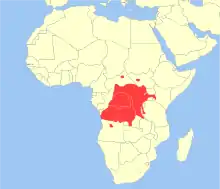Red-tailed monkey
The red-tailed monkey, also known as the black-cheeked white-nosed monkey, red-tailed guenon, redtail monkey, or Schmidt's guenon (Cercopithecus ascanius) is a species of primate in the family Cercopithecidae.
| Red-tailed monkey[1] | |
|---|---|
.jpg.webp) | |
| Semliki Wildlife Reserve, Uganda | |
| Scientific classification | |
| Kingdom: | Animalia |
| Phylum: | Chordata |
| Class: | Mammalia |
| Order: | Primates |
| Suborder: | Haplorhini |
| Infraorder: | Simiiformes |
| Family: | Cercopithecidae |
| Genus: | Cercopithecus |
| Species: | C. ascanius |
| Binomial name | |
| Cercopithecus ascanius (Audebert, 1799) | |
 | |
| Geographic range | |
It is found in Angola, Cameroon, Central African Republic, Democratic Republic of the Congo, Kenya, Rwanda, South Sudan, Tanzania, Uganda, Zambia, and possibly Burundi. The red-tailed monkey is usually black, red, or orange. Although native to this region, it has spread north and south as well as it can survive in different habitats and under different conditions. It is a distinct creature in its habitats and is gradually becoming endangered due to deforestation and over-exploitation through hunting and predation.
Taxonomy and classification
All primates are within the class Mammalia due to the distinguishing features of all mammals such as mammary glands, hair, and placental delivery of young. Primates are then in the Order Primates which is separated into two Sub-orders, Haplorhini and Strepsorhini. Sub-order Haplorhini is characterized by having a dry nose and nostrils that are oval in shape while sub-order Strepsorhini have moist noses with nostrils that are elliptical in shape. The red-tailed guenon is within the sub-order Haplorhini which is separated into two parvorders. Parvorder Catarrhini are the Old World monkeys and parvorder Platyrrhini are New World monkeys. Red-tailed monkeys are within the Parvorder Catarrhini and have nostrils that point downward which differs from the Platyrrhini which have nostrils that point to the sides. The overall classification of the red-tailed monkey is:
- Kingdom Animalia
- Phylum Chordata
- Class Mammalia
- Order Primates
- Sub-order Haplorhini
- Parvorder Catarrhini
- Family Cercopithecidae
- Genus Cercopithecus
- Subspecies ascanius ascanius
- Subspecies ascanius atrinasus
- Subspecies ascanius katangae
- Subspecies ascanius whitesidei
- Subspecies ascanius schmidti
- Genus Cercopithecus
- Family Cercopithecidae
- Parvorder Catarrhini
- Sub-order Haplorhini
- Order Primates
- Class Mammalia
- Phylum Chordata
Anatomy
Distinguishing features
.jpg.webp)

The red-tailed monkey is named as it sounds, for its red coloration of the tail's underside as well as the bi-coloration of the tail as the reddish color increases from the base to the tip. There are other features characteristic to this mammal as well such as the white nose and cheeks in the midst of black or dark grey body fur. Red-tailed monkeys also have very large, elastic cheeks which are used in gathering food and storing it in their mouths for safety.[3]
Size
Sizes of their bodies range between individuals as well as between the sexes as males are larger than the females. Body length ranges from 1 to 2 foot (12-24 inches), without the tail included, males being on the upper end of the scale and females being on the lower. Adult males also weigh between 7 and 10 pounds and females weigh slightly less between 6 and 8 pounds. The tail length can reach up to 35 inches long which can be twice the body length for some red-tailed monkeys. The tail helps the monkeys achieve balance.
Behavior
Communication and vocalization
Red-tailed monkeys communicate using different methods which are characteristic of communicating specific behaviors or things. Physical and vocal communication are used between members of social groups of these monkeys to demonstrate social dominance, submissiveness, or greeting. Vocal communication is used between members of social groups of red-tailed monkeys in which the more submissive monkey will make a soft, oscillating call to its elder. Physical communication is exhibited in nose to nose greetings where two red-tailed guenons touch their noses together. This is a sign of affection and can be followed by playful behavior. Visual communication is used as a sign of warning to others to stay away and as a defense against predators. Red-tailed monkeys practice staring or staring with their mouth open. When these monkeys implement staring, they lift their eyebrows to retract the skin on their forehead which makes the skin on the face expand backwards revealing the underneath of their eyelids. On the dark fur background, their eyelids can be seen very easily by others and understand it as a display that the red-tailed monkey is being threatened and the other species needs to stay away. Head-bobbing is another threat display in which the monkey moves its head up and down. These types of communication can be used separately or together depending on how threatened the monkey feels to its surroundings.[4] Other types of communication are used such as chemical and olfactory communication; however, not much information is available on this type of communication.
Feeding habits
Red-tailed monkeys are primarily fructivorous, but are considered omnivorous because they will eat leaves, flowers, or insects in times where fruit is scarce. As they forage, these monkeys gather their findings in the expandable cheeks of their mouths. The pouches will hold a large amount of food where they can forage in one area and then carry their food away to another location where it is safe to consume without the threat of another stealing from them.[3]
Social structure
Red-tailed monkeys are social primates that form groups that can range in size from 7 to 30 individuals. The groups consist of one dominant male and females and their offspring, male or female juveniles. Groups generally stay together through all periods of the day and through life, except for males who reach maturity. These males will leave the group they were born into and go on to form all male groups with other red-tailed monkey males or survive alone until they can replace the dominant male of a different social group.[5] The females practice allomaternal care in which the various females in a group will help take care of their own young as well as the young of other females in the group. Often, the different social groups will congregate for support from each other when food is unlimited and in abundance.[6]
Activity and habitat
Red-tailed monkeys are active in the early morning and evening which is characterized as diurnal activity. They act as important seed dispersers as they collect fruit and other food items. Their dispersal is throughout the tropical forest of in East and Central Africa ranging to Kenya and many areas of the Congo. The red-tailed monkey species is categorized in recognized subspecies and these subspecies have different ranges, the subspecies C. a. schmidti having the widest distribution from Congo into countries of Kenya, Tanzania, and Uganda and the subspecies C. a. atrinasus having the smallest distribution restricted to a local habitat of Zovo, Angola.[7] They are primarily arboreal but will come to the ground. In the trees, they are very active and travel at greater speeds than being on the ground. On the ground, they travel quadrupedally, on all four legs. While they show a dominating preference for being arboreal in activity and where they choose to rest, they forage on the ground and as a result, they spend an adequate amount of their time on the forest floor as well.[8]
Reproduction
Like all placental mammals, red-tailed monkeys produce viviparous young. They tend to only give birth to a single young per mating season.[3] Their mating system is characterized as polygynous meaning that one male mates with multiple females and is a common sight in mammals due to advantages of the grouped social system. The most prominent and successful mating season is from the month of November extending into the month of February; however, breeding can occur throughout the course of an entire year.[6] In some studies, it has been seen that the red-tailed monkey will interbreed and hybridize with another species in its genus: the blue monkey (C. mitis). The hybrids have been seen on the terrestrial island of Gombe, Tanzania, and this hybridization could serve a vital purpose in the reproduction of both the red-tailed and blue monkey species, and quite possibly, produce a new species in the future.[9]
Conservation status
Conservation efforts for the red-tailed monkey are of "least concern" as listed by the IUCN Red List of Threatened Species.[2] This has been justified because this species of monkey is located at many different habitats throughout the Congo and throughout East-Central Africa. Also, the species is quite abundant in these areas and they have an average lifespan of about 28 years.[3] The red-tailed monkey is subject to predation by crowned eagles, wild cats, and occasionally, humans and chimpanzees. Despite the influence of predation on their population, no major threat to this species in terms of endangerment is posed, although some locations of their habitat suffer from deforestation and hunting pressure as well.
References
- Groves, C. P. (2005). Wilson, D. E.; Reeder, D. M. (eds.). Mammal Species of the World: A Taxonomic and Geographic Reference (3rd ed.). Baltimore: Johns Hopkins University Press. pp. 154–155. ISBN 0-801-88221-4. OCLC 62265494.
- Oates, J. F.; Hart, J.; Groves, C. P. & Butynski, T. M. (2008). "Cercopithecus ascanius". IUCN Red List of Threatened Species. 2008: e.T4212A10654844. doi:10.2305/IUCN.UK.2008.RLTS.T4212A10654844.en.
- "Schmidt's red-tailed monkey". Smithsonian's National Zoo. 2016-04-25. Retrieved 2016-11-28.
- Flannery, Sean. "Red-tail Monkey (Cercopithecus ascanius)". www.theprimata.com. Retrieved 2016-11-28.
- "Red-Tailed guenon (Cercopithecus ascanius)" (PDF). The Maryland Zoo in Baltimore. February 15, 2014. Retrieved November 28, 2016.
- "Cercopithecus ascanius (black-cheeked white-nosed monkey)". Animal Diversity Web. Retrieved 2016-11-28.
- "Red-tail Monkey - Cercopithecus ascanius - Details - Encyclopedia of Life". Encyclopedia of Life. Retrieved 2016-11-29.
- Bektic, Lejla (2009). "Habitat Preference and Foraging Behaviour in Adult Red-tailed Monkeys (Cercopithecus ascanuis)" (PDF). Swedish University of Agricultural Sciences Department of Animal Environment and Health Ethology and Animal Welfare Programs. Retrieved November 29, 2016.
- Detwiler, Kate M. (2004-01-01). "Hybridization between Red-tailed Monkeys (Cercopithecus ascanius) and Blue Monkeys (C. Mitis) in East African Forests". In Glenn, Mary E.; Cords, Marina (eds.). The Guenons: Diversity and Adaptation in African Monkeys. Developments in Primatology: Progress and Prospects. Springer US. pp. 79–97. doi:10.1007/0-306-48417-x_7. ISBN 9780306473463.
External links
| Wikimedia Commons has media related to Cercopithecus ascanius. |
